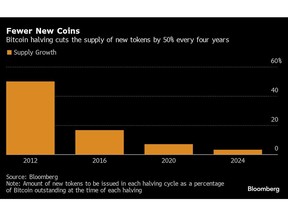Article content
(Bloomberg) — A highly anticipated Bitcoin software update called the “halving” has been completed, dealing a potential blow to the companies that make money by ensuring that the digital currency functions smoothly and securely.
The once-every-four-years event cut in half the so-called mining reward, which is the amount of Bitcoin released from the network to compensate companies known as miners for validating transactions. The modification went into effect as of 8:10 p.m. Friday evening New York time, according to data from analytics website mempool.space and Blockchain.com.
Article content
This was all by design and preordained by the code that runs Bitcoin’s blockchain. The supposed anonymous creator of Bitcoin, Satoshi Nakamoto, sought to use the halving mechanism to maintain an eventual hard cap of 21 million Bitcoin in order to keep the original cryptocurrency from being inflationary. As a result of this halving, the fourth since 2012, the daily reward paid to miners will drop to 450 Bitcoin from 900.
Bitcoin advocates expect the halving to be a positive catalyst for the latest bull market since it further reduces the supply of new tokens at a time when demand for them has risen from new exchange-traded funds that directly hold the digital asset. Proponents of the original cryptocurrency such as MicroStrategy Inc. Chairman Michael Saylor have touted it is a better store of value than traditional fiat currencies, which they say are more vulnerable to inflation.
Still, while Bitcoin has rallied to records following past halvings, market watchers including analysts from JPMorgan Chase & Co. and Deutsche Bank AG have said that the event was pretty much priced into the market.
Article content
Notably, the dilutive effect of Bitcoin mining decreases with each halving. While the number of tokens mined in the cycle that followed the first halving amounted to 50% of Bitcoin outstanding at the time the halving took effect, new supply in the upcoming cycle will only amount to 3.3%, according to data compiled by Bloomberg.
The main impact from this halving is expected to be on Bitcoin mining companies rather than the actual price of the cryptocurrency.
Read more: Bitcoin ‘Halving’ Will Deal a $10 Billion Blow to Crypto Miners
The blockchain update is poised to wipe out billions of dollars in annual revenue for miners, though the effect will be mitigated if the cryptocurrency’s price continues to rise.
Bitcoin mining is an energy-intensive process, in which miners use specialized computers to validate transactions on the blockchain. Large-scale miners such as Marathon Digital Holdings Inc. and Riot Platforms Inc. have spent billions of dollars on acquiring energy, purchasing mining equipment and building out data centers.
JPMorgan expects the sector to consolidate, with publicly-traded firms gaining market share.
Article content
“Publicly-listed Bitcoin miners are well positioned to take advantage of the new environment, mainly due to greater access to funding and in particular equity financing,” JPMorgan analysts wrote in a note this week. “This helps them to scale their operations and invest into more efficient equipment.”
Past halvings have been completed with no discernible disruption to the functioning of the Bitcoin blockchain.
The next halving is set to take place in 2028 and the reward will be reduced to 1.5625 from 3.125 for a miner that successfully processes a block of transaction data. The average time to finish a block is around 10 minutes. There are expected to be 64 Bitcoin halvings before the 21 million cap is reached sometime around 2140, at which point halvings will cease and the blockchain will stop issuing new tokens.
Read More: What Is Bitcoin ‘Halving’? Does It Push Up the Price?: QuickTake
When that happens, Bitcoin miners will have to rely on transaction fees, their other revenue source besides mining rewards. Rising transaction fees may help some miners stay afloat as the rewards continue to dwindle, yet those fees are currently only a small portion of total revenue for miners.
—With assistance from María Paula Mijares Torres.
Share this article in your social network

